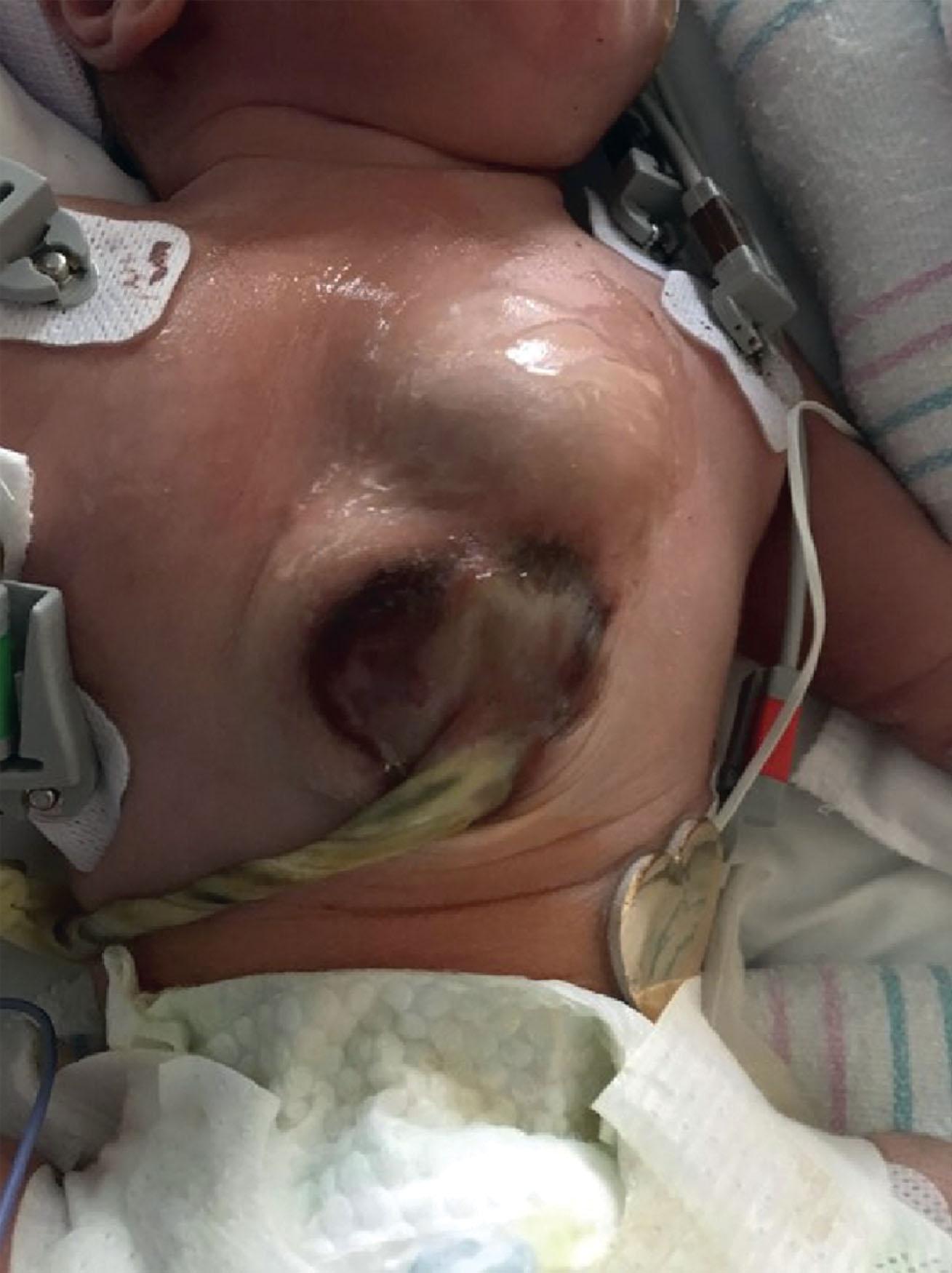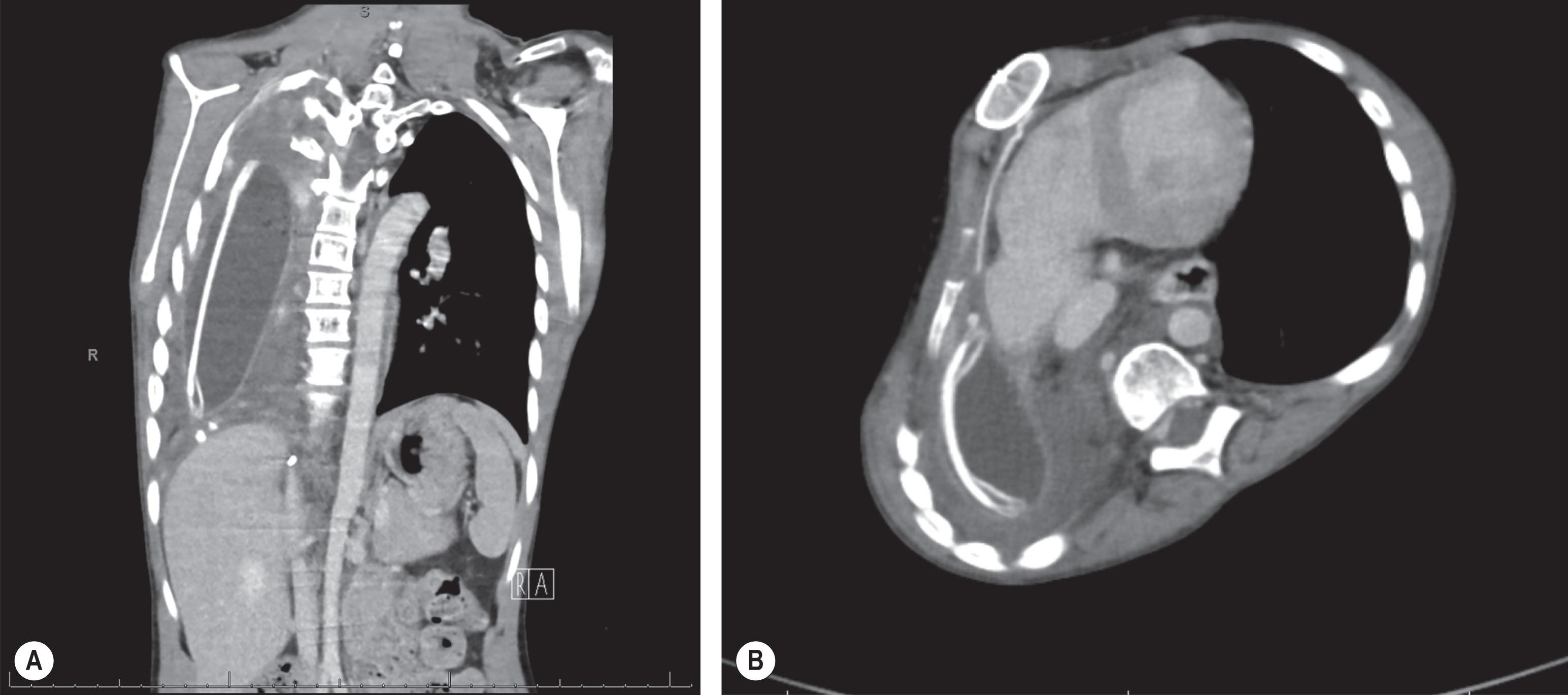Physical Address
304 North Cardinal St.
Dorchester Center, MA 02124
![]() Access video content for this chapter online at Elsevier eBooks+
Access video content for this chapter online at Elsevier eBooks+
Pediatric chest and trunk wall abnormalities are oftentimes congenital in nature, however a significant portion of our expertise as plastic and reconstructive surgeons is utilized to solve problems that arise as a consequence of surgeries performed for other congenital anomalies. Because of this, reconstruction of the pediatric chest or trunk deformity frequently requires coordination with other specialties to achieve the optimal results. Unique considerations for reconstruction in the pediatric patient include the impact of surgery on the growth of the child, the relative paucity of tissues, as well as the significant impact that closure may have on the child’s physiology. Reconstruction of the ventral chest and trunk could have significant impact on the cardiac, pulmonary, and gastrointestinal systems, while reconstruction of the dorsal back will require consideration of the neurological system.
Development of the body wall and cavities occur during the 4th to 8th weeks of gestation. During this time pericardial, pleural, and peritoneal cavities develop. Concurrently, the wall of the trunk is formed by folding of the mesoderm around these structures. On the dorsal aspect, the paraxial mesoderm folds around the neural tube and differentiates into the musculoskeletal structures which surround the central nervous system. On the ventral aspect, the lateral plate mesoderm folds inward and medially to surround the aforementioned developing body cavities, differentiating into the soft tissue and bony components of the chest and abdomen. During the 6th to 8th weeks of development the diaphragm forms, separating the thoracic and abdominal cavities. Interruption of this folding process at the dorsal and ventral aspects will result in posterior back defects and anterior chest/abdominal wall defects, respectively.
Occurring at a rate of 5–8 per 1,000,000 live births and affecting males more commonly than females, ectopia cordis encompasses a spectrum of midline defects of the sternum. These range from the relatively innocuous bifid sternum to the most severe forms where the heart is displaced from the thoracic cavity, which is associated with high mortality rates ( ![]() ). In addition to their chest wall defects, 80.2% patients with ectopia cordis present with concomitant intracardiac abnormalities ranging from isolated atrio-ventricular septal defects to tetralogy of Fallot. Various classification systems for ectopia cordis have been developed and are largely based on the location of the heart at birth. One such classification developed by Shamberger and Welch stratifies ectopia cordis into four categories: cervical, thoracic, thoraco-abdominal, and bifid sternum or sternal cleft. Excluding cleft sternum, ectopia cordis has an associated mortality rate ranging from 59% to 96%. Of these, thoraco-abdominal subtypes are associated with the best prognosis with a mortality rate of approximately 50% while cervical subtypes, to date, have been incompatible with life. The thoraco-abdominal form of ectopia cordis is often associated with the pentalogy of Cantrell, whose defining features are a midline abdominal wall defect, low sternal defect, anterior diaphragmatic defect, pericardial defect, and intracardiac abnormalities ( Fig. 32.1 ). Ectopia cordis can be detected on ultrasound as early as during the first trimester, thereby allowing time to convene a multidisciplinary group of obstetricians, neonatologists, cardiologists, specialized anesthesiologists, cardiothoracic surgeons, pediatric surgeons, and plastic surgeons to develop a plan for treatment.
). In addition to their chest wall defects, 80.2% patients with ectopia cordis present with concomitant intracardiac abnormalities ranging from isolated atrio-ventricular septal defects to tetralogy of Fallot. Various classification systems for ectopia cordis have been developed and are largely based on the location of the heart at birth. One such classification developed by Shamberger and Welch stratifies ectopia cordis into four categories: cervical, thoracic, thoraco-abdominal, and bifid sternum or sternal cleft. Excluding cleft sternum, ectopia cordis has an associated mortality rate ranging from 59% to 96%. Of these, thoraco-abdominal subtypes are associated with the best prognosis with a mortality rate of approximately 50% while cervical subtypes, to date, have been incompatible with life. The thoraco-abdominal form of ectopia cordis is often associated with the pentalogy of Cantrell, whose defining features are a midline abdominal wall defect, low sternal defect, anterior diaphragmatic defect, pericardial defect, and intracardiac abnormalities ( Fig. 32.1 ). Ectopia cordis can be detected on ultrasound as early as during the first trimester, thereby allowing time to convene a multidisciplinary group of obstetricians, neonatologists, cardiologists, specialized anesthesiologists, cardiothoracic surgeons, pediatric surgeons, and plastic surgeons to develop a plan for treatment.

The first successful ectopia cordis repair was performed by Koop in 1975 in a staged fashion. In kind, multistage repair is the most common approach to surgical correction performed today. At the time of birth, soft-tissue coverage of the exposed heart is performed to prevent fluid loss, cardiac desiccation, and trauma to the heart. Soft-tissue coverage can be achieved in numerous ways including bilateral pectoral skin flaps, split-thickness skin grafts, cadaveric skin grafts, or a number of synthetic or biologic meshes. Due to the hypoplastic thoracic cavity, attempted reduction of the heart into the thoracic cavity is deferred as cardiopulmonary compromise can occur with compression of the heart or kinking of the great vessels.
The second stage of reconstruction involves reduction of the heart into the thoracic cavity when it is large enough to accommodate the heart without undue pressure. The increase in thoracic cavity volume is achieved with patient growth or a number of adjunctive procedures such as pleurotomy, partial sacrifice of lung or liver, hemidiaphragm plication, partial or total thymectomy, or division of the costal cartilages. There is considerable debate regarding the timing of this stage. Proponents for early reduction at several months old cite early protection for the mediastinal structures and the return to normal intrathoracic pressure as supporting factors. Others suggest delay until 1.5–2 years of age if the patient is otherwise stable to allow for the natural growth to provide the thoracic volume required for reduction of the heart.
After replacement of the heart into the thoracic cavity, chest wall reconstruction can then be performed. Reconstruction of the rigid chest wall is preferentially achieved with autologous bone grafts harvested from donor sites such as the ribs, cranium, or ilium. Autologous reconstruction is favored due to decreased risk of infection and its ability to remodel with subsequent growth. Alloplastic materials such as polytetrafluoroethylene, titanium struts, methyl methacrylate, and polypropylene mesh may be employed should the patient have insufficient autologous tissues to reconstruct the chest wall. Ultimately, the rigid chest wall reconstruction is then covered with musculocutaneous flaps to provide adequate vascularized soft tissue. Although staged repairs are most commonly performed due to the stated reasons above, single-stage repairs have been performed when hemodynamic instability and complex intracardiac anomalies necessitate it.
Sternal clefts without an exposed heart are significantly less complicated. Surgical repair can often be performed when the patient is able to safely undergo anesthesia and tolerate a small volume of blood loss. Depending on the severity of the sternal cleft, repair of this defect has ranged from closing wedge osteotomies in the case of bifid sternums to bilateral pectoralis major muscle advancement flaps over rib grafts ( ![]() ). These repairs provide durable, protective coverage over the mediastinum with good cosmetic outcomes.
). These repairs provide durable, protective coverage over the mediastinum with good cosmetic outcomes.
A rare complication after pneumonectomy, postpneumonectomy syndrome occurs due to the vicious cycle of mediastinal shifting resulting in stretching and compression of the mainstem bronchus which leads to obstructive symptoms and lung hyperexpansion ultimately resulting in further mediastinal shifting. This syndrome typically presents months to years after pneumonectomy as intermittently worsening dyspnea, respiratory infection, cardiovascular instability, and thoracic musculoskeletal deformities. Although not unique to the pediatric population, it occurs more frequently in pediatric patients. In a study done by Podevin, 17% of children who underwent pneumonectomy developed postpneumonectomy syndrome. It is hypothesized that children are more prone to develop this syndrome due to the greater elasticity of their tissues resulting in a mediastinum that is more mobile. Additionally, right-sided pneumonectomies tend to have an increased rate of postpneumonectomy syndrome, likely due to the fact that the left thoracic cavity has the heart to act as an autologous filler. Treatment and prevention of postpneumonectomy syndrome involves filling the uninhabited hemithorax with material to correct or prevent mediastinal shifting. Delay in diagnosis of postpneumonectomy syndrome occurs frequently due to its similarities with asthma, gastrointestinal reflux, and other common illnesses. This delay in diagnosis can be fatal as untreated postpneumonectomy syndrome can lead to irreversible bronchomalacia.
Several implantable prosthetics have been used to fill the resultant dead space following pneumonectomy including Lucite balls, silastic breast implants, and testicular prosthesis. These implants have shown to provide immediate relief of symptoms as well as improvement of physiological parameters such as forced expiratory volume and bronchial diameter. Due to the higher rate of postpneumonectomy syndrome in pediatric patients along with its potentially fatal consequences, some centers have prophylactically placed saline-based tissue expanders into the vacant hemithorax following pneumonectomy. The usage of a tissue expander rather than the other implants mentioned is advantageous for the pediatric patient as it can intermittently be expanded in an outpatient setting as the child grows ( Fig. 32.2 ). Insertion of tissue expanders as treatment or in a prophylactic manner has its own set of complications to be considered, including rupture or leaking of the implant which may require multiple operations over the lifetime of the child for replacement.

Sternal wound infections and wound dehiscence are complications observed in pediatric patients undergoing cardiac and thoracic procedures with an incidence ranging from 0.5%–16% following surgery. Complications may be superficial or deep in nature and can be associated with significant morbidity. The high rate of these complications in the pediatric population are hypothesized to be multifactorial and influenced by the use of antibiotic prophylaxis and timing of the sternal wound closure following cardiac surgery. Additionally, the severity of underlying cardiac disease has been positively correlated with postoperative wound complications. Given the minimal reserve that these patients have, durable, definitive closure of these wounds is paramount to recovery. As with other forms of wound closures, the principles of treating sternal wound dehiscence and infections remain the same: treatment of infection including removal of hardware if feasible, debridement of nonviable tissue, and optimizing the patient’s status for closure of the wound.
Become a Clinical Tree membership for Full access and enjoy Unlimited articles
If you are a member. Log in here